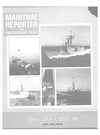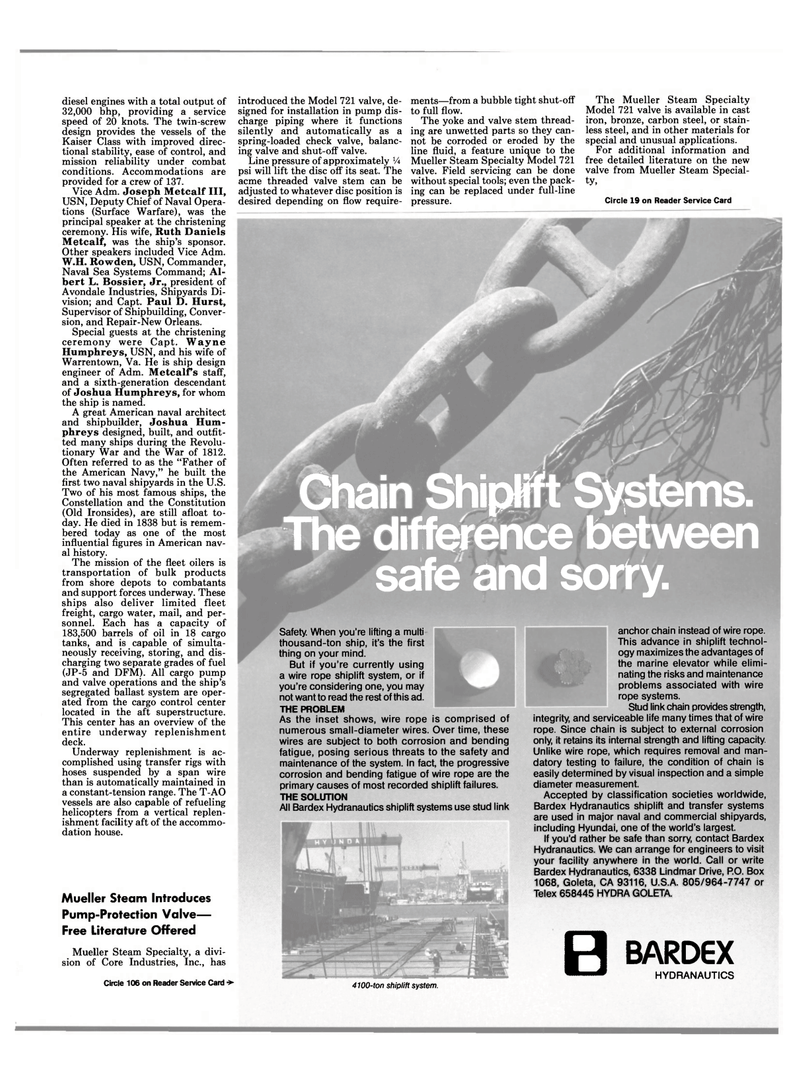
Page 83: of Maritime Reporter Magazine (April 1986)
Read this page in Pdf, Flash or Html5 edition of April 1986 Maritime Reporter Magazine
diesel engines with a total output of 32,000 bhp, providing a service speed of 20 knots. The twin-screw design provides the vessels of the
Kaiser Class with improved direc- tional stability, ease of control, and mission reliability under combat conditions. Accommodations are provided for a crew of 137.
Vice Adm. Joseph Metcalf III,
USN, Deputy Chief of Naval Opera- tions (Surface Warfare), was the principal speaker at the christening ceremony. His wife, Ruth Daniels
Metcalf, was the ship's sponsor.
Other speakers included Vice Adm.
W.H. Rowden, USN, Commander,
Naval Sea Systems Command; Al- bert L. Bossier, Jr., president of
Avondale Industries, Shipyards Di- vision; and Capt. Paul D. Hurst,
Supervisor of Shipbuilding, Conver- sion, and Repair-New Orleans.
Special guests at the christening ceremony were Capt. Wayne
Humphreys, USN, and his wife of
Warrentown, Va. He is ship design engineer of Adm. MetcalFs staff, and a sixth-generation descendant of Joshua Humphreys, for whom the ship is named.
A great American naval architect and shipbuilder, Joshua Hum- phreys designed, built, and outfit- ted many ships during the Revolu- tionary War and the War of 1812.
Often referred to as the "Father of the American Navy," he built the first two naval shipyards in the U.S.
Two of his most famous ships, the
Constellation and the Constitution (Old Ironsides), are still afloat to- day. He died in 1838 but is remem- bered today as one of the most influential figures in American nav- al history.
The mission of the fleet oilers is transportation of bulk products from shore depots to combatants and support forces underway. These ships also deliver limited fleet freight, cargo water, mail, and per- sonnel. Each has a capacity of 183,500 barrels of oil in 18 cargo tanks, and is capable of simulta- neously receiving, storing, and dis- charging two separate grades of fuel (JP-5 and DFM). All cargo pump and valve operations and the ship's segregated ballast system are oper- ated from the cargo control center located in the aft superstructure.
This center has an overview of the entire underway replenishment deck.
Underway replenishment is ac- complished using transfer rigs with hoses suspended by a span wire than is automatically maintained in a constant-tension range. The T-AO vessels are also capable of refueling helicopters from a vertical replen- ishment facility aft of the accommo- dation house. introduced the Model 721 valve, de- signed for installation in pump dis- charge piping where it functions silently and automatically as a spring-loaded check valve, balanc- ing valve and shut-off valve.
Line pressure of approximately Vi psi will lift the disc off its seat. The acme threaded valve stem can be adjusted to whatever disc position is desired depending on flow require- ments—from a bubble tight shut-off to full flow.
The yoke and valve stem thread- ing are unwetted parts so they can- not be corroded or eroded by the line fluid, a feature unique to the
Mueller Steam Specialty Model 721 valve. Field servicing can be done without special tools; even the pack- ing can be replaced under full-line pressure.
The Mueller Steam Specialty
Model 721 valve is available in cast iron, bronze, carbon steel, or stain- less steel, and in other materials for special and unusual applications.
For additional information and free detailed literature on the new valve from Mueller Steam Special- ty,
Circle 19 on Reader Service Card
Mueller Steam Introduces
Pump-Protection Valve—
Free Literature Offered
Mueller Steam Specialty, a divi- sion of Core Industries, Inc., has
Circle 106 on Reader Service Card •>• 4100-ton shiplift system.
Chain ShipHft Systems. The difference between safe and sorfy.
Safety. When you're lifting a multi thousand-ton ship, it's the first thing on your mind.
But if you're currently using a wire rope shiplift system, or if you're considering one, you may not want to read the rest of this ad.
THE PROBLEM
As the inset shows, wire rope is comprised of numerous small-diameter wires. Over time, these wires are subject to both corrosion and bending fatigue, posing serious threats to the safety and maintenance of the system. In fact, the progressive corrosion and bending fatigue of wire rope are the primary causes of most recorded shiplift failures.
THE SOLUTION
All Bardex Hydranautics shiplift systems use stud link anchor chain instead of wire rope.
This advance in shiplift technol- ogy maximizes the advantages of the marine elevator while elimi- nating the risks and maintenance problems associated with wire rope systems.
Stud link chain provides strength, integrity, and serviceable life many times that of wire rope. Since chain is subject to external corrosion only, it retains its internal strength and lifting capacity.
Unlike wire rope, which requires removal and man- datory testing to failure, the condition of chain is easily determined by visual inspection and a simple diameter measurement.
Accepted by classification societies worldwide,
Bardex Hydranautics shiplift and transfer systems are used in major naval and commercial shipyards, including Hyundai, one of the world's largest.
If you'd rather be safe than sorry, contact Bardex
Hydranautics. We can arrange for engineers to visit your facility anywhere in the world. Call or write
Bardex Hydranautics, 6338 Lindmar Drive, P.O. Box 1068, Goleta, OA 93116, U.S.A. 805/964-7747 or
Telex 658445 HYDRA GOLETA.
B BARDEX HYDRANAUTICS

 82
82

 84
84
